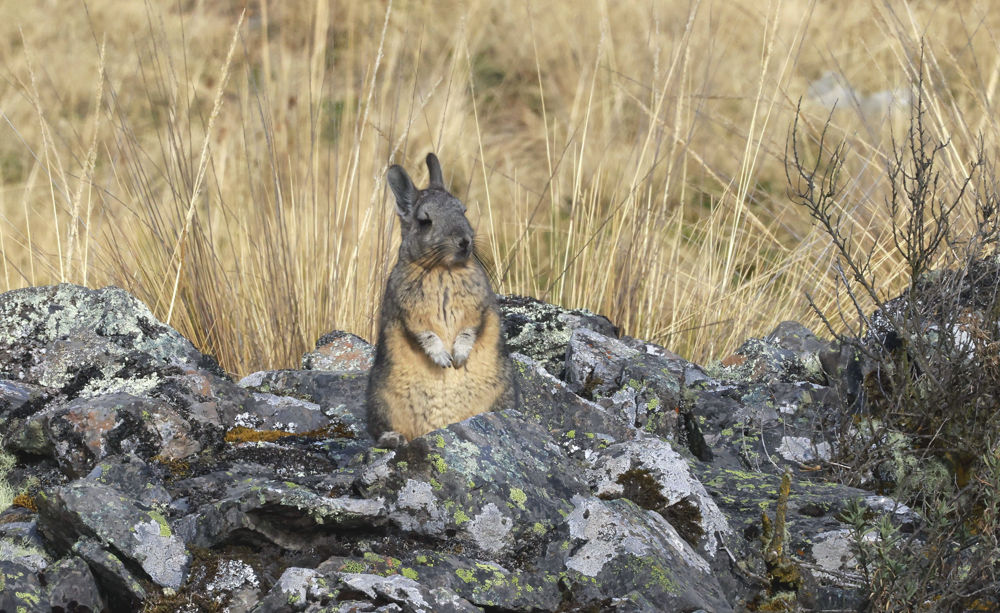Departure Date: September 21 - October 3, 2025
Compiled By: Andrew Whittaker
Trip Leaders: Andrew Whittaker, Local Leader
Toll Free: 800.328.8368
Phone: 512.328.5221
Grand Bolivia: Part II 9/21/2025-10/3/2025

https://ebird.org/tripreport/422288
Bolivia outdid itself once again as we explored the spectacular Andes, where the many pristine habitats produced countless cool endemics, near-endemics, and lifers. From the breathtaking cloud forest and puna to magnificent Lake Titicaca with its flightless grebe, the highlands never let us down. This scenic region is a botanist’s paradise, too, with marvelous orchids, fascinating passion flowers, and wild fuchsia adding a blaze of color. Our explorations rewarded us with a fabulous 290 bird species, making an incredible grand total of nearly 600 on Parts I and II of this exciting tour!

Band-tailed Fruiteater male © Andrew Whittaker
We began in bustling Cochabamba, where we met Jeannie at our hotel in the late afternoon. Our first full day got us off to a flying start, birding a lovely secluded ridge in the spectacular cloud forest above the city, where the ancient trees were dripping with exotic bromeliads, orchids, and mosses. Among the many avian gems here were the Blue-banded Toucanet, Tyrian and Scaled metaltails, Gould’s Inca, Violet-throated Starfrontlet, Pearled Treerunner, Light-crowned Spinetail, Barred Fruiteater, Rufous-breasted Chat-Tyrant, Citrine Warbler, Spectacled Redstart, the endemic Gray-bellied Flowerpiercer, and the Grass-green, Chestnut-bellied, and Scarlet-bellied Mountain tanagers. After a superb lunch of fresh trout, we birded the nearby lake, which produced the Variable Hawk, Mountain Caracara, Yellow-billed Pintail, Yellow-billed Teal, Puna and Andean ibis, Andean Lapwing, Andean Gull, Andean Swallow, and Band-tailed and Plain-colored seedeaters.
The next day’s visit to some mid-elevation forest provided more superb birding, with a stunning line-up of Chestnut-tipped Toucanet, Yungas Guan, Burrowing Owl, Masked Trogon, Versicolored Barbet, Scaly-naped Amazon, Yungas Manakin, and Yungas and Riverbank warblers. Tanagers provided a kaleidoscope of colors with Magpie, Fawn-breasted, Orange-eared, Blue-necked, Green-throated, Blue-capped, Golden, and Saffron-crowned. We found the sought-after Yungas Tody-Tyrant, while a Pavonine Cuckoo and an early Olive-sided Flycatcher were big surprises. We returned to our hotel in the mid-afternoon.

Chestnut-tipped Toucanet © Andrew Whittaker
Our trip to Cerro Tunari was dominated by magnificent scenery as we enjoyed yet another super day in agricultural valleys, highland Polylepis forest, and the scenic puna. On a gorgeous calm and sunny day, we found the hillsides teeming with our most wanted birds, especially hummingbirds. The dazzling colors of Red-tailed Comets, Wedge-tailed Hillstars, and Giant Hummingbirds were spellbinding. Other noteworthy encounters were the cool-looking and near-endemic Rufous-bellied Mountain Tanager (Saltator) and the Sierran form of the Olive-crowned Crescentchest.
This rich area also produced Gray-hooded Parakeet, Yellow-billed Tit-Tyrant, Gray-bellied Flowerpiercer, Streak-fronted Thornbird, Brown-capped and Tawny tit-spinetails, Rock Earthcreeper, and Rufous-sided, Ringed, and Bolivian warbling finches. The breathtaking scenery of the dry puna was dotted with scarlet cactus; here we enjoyed magical looks at Mountain Caracara before moving up to lovely meadows inhabited by herds of Alpaca and Llama. Soon we encountered our first ground-tyrants, with close looks at Taczanowski’s, Ochre-naped, and White-browed. Farther up, we ran into grazing Andean Geese, Andean Swifts, d’Orbigny’s Chat-Tyrant, Glacier Finch, Bright-rumped Yellow-Finch, and both Ash-breasted and Plumbeous Sierra Finch.
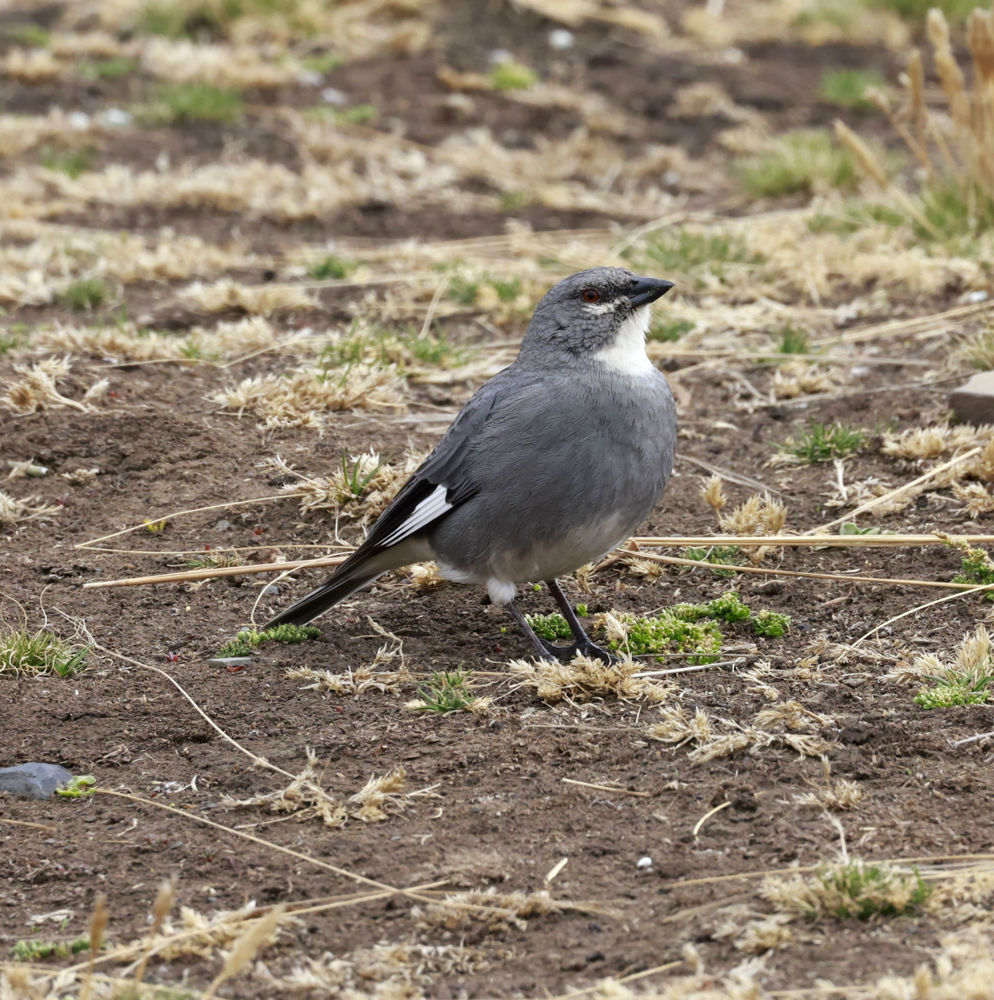
Glacier Finch © Photo Andrew Whittaker
Crested Ducks and Andean Flickers graced our picnic spot. A stop at the city lake in Cochabamba turned up Silvery Grebe (the Andean form—a good candidate for a split), Andean Duck, Rosy-billed Pochard, Cinnamon Teal, White-cheeked Pintail, and Black-necked Stilt.
Next morning we took the short flight to La Paz. We met Marco at the airport, then made our way through the city to our lovely hotel on the banks of famous Lake Titicaca. After a fabulous lunch, we had an instructive visit to the hotel’s fascinating museum of the indigenous Utama people, where we photographed the famous reed boats: it’s amazing to think that crafts like these let people from South America settle the tiny atolls of Polynesia, 4,300 miles away across the Pacific Ocean!
Exploring the reed-edged lake and hotel grounds revealed a delightful pair of Aplomado Falcons, Spot-winged Pigeon, Peruvian Sierra Finch, Black Siskin, Black-throated Flowerpiercer, and Cinerous Conebill. The lakeside offered the colorful Many-colored Rush Tyrant, Wren-like Rush Bird, Slate-colored Coot, male Andean Ducks displaying to females, Puna Teal, White-tufted Grebe, and Plumbeous Rail. And, of course, we had exceptional studies of the magnificent flightless Titicaca Grebe.

Near endemic Titicaca Grebe offered stunning views © Photo Andrew Whittaker
The next morning found us driving past the spectacular snow-capped Illampu Mountain, its peak at 20,892 feet, on our way to bird the slopes and farmland near Sorata. This secluded valley gave us magical views of the rare and often hard-to-see endemic Berlepsch’s Canastero. Among the delightful hummingbirds here were the Red-tailed Comet, Green-tailed Trainbearer, and—WOW—the mind-blowing endemic Black-hooded Sunbeam in all its beauty, which gave us mega views as it fed and sang. Hard to exaggerate the beauty of this spectacular hummer!
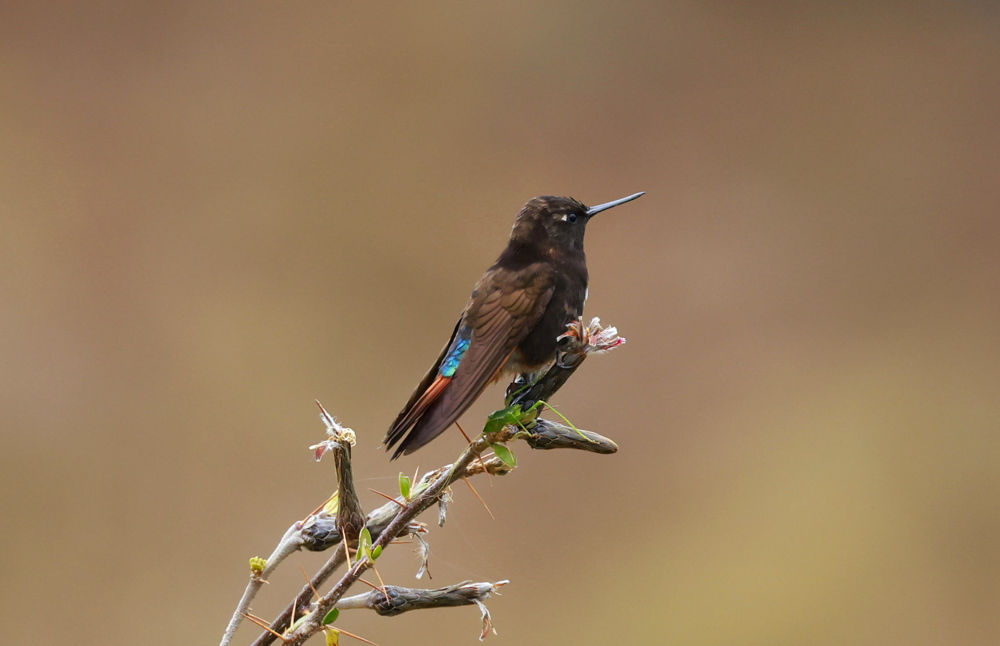
The mind-blowing endemic Black-hooded Sunbeam © Photo Andrew Whittaker
The highlands rewarded us with Hellmayr’s Pipit and Black-billed Shrike-Tyrant; Huayaco Tinamou and Darwin’s Nothura were heard. On an isolated lake, we were happy to find the extremely localized Giant Coots displaying their enormous red-lobed feet and tricolored bills. Additionally, migrant Baird’s Sandpipers and a very confiding Common Miner put on a show; the miner is likely to be split in the future.
A boat trip took us to the famous floating homes of the Uros Indians, perched on artificial islands of totora reeds. Along the dirt roads through the reedbeds, we were able to enjoy a hunting female Cinereous Harrier, Yellow-winged Blackbirds, and a tame Andean Lapwing.

Confiding Andean Lapwing © Andrew Whittaker
Early the next morning, we descended into the crazy traffic of La Paz before ascending the other side to the spectacular La Cumbre mountain pass. Up in this moon-like landscape, Indio managed to locate a pair of cool-looking Rufous-bellied Seedsnipe, and we were happy to encounter a couple of new high-altitude species, the Streak-throated Canastero and Puna Ground-Tyrant.
We continued our descent into this breathtaking valley to enjoy a lunch of fresh trout filet, after which we drove through mile after mile of spectacular cloud forest and through deep tunnels before arriving at the top of the famous Death Road. A brief walk here was highlighted by a veritable feast of hummingbirds, with Amethyst-throated Sunangel, Gould’s Inca, Blue-capped Puffleg, and White-bellied Woodstar. Arriving mid-afternoon at our lovely Coroico hotel, we enjoyed a delightful afternoon stroll through the hotel’s rich yungas forest, where we marveled at great studies of spectacular Versicolored Barbet, Amazonian Motmot, Ocellated Piculet, Rufous Casiornis, Upland and Chestnut-backed antshrikes, Yellow-bellied Siskin, Chestnut-bellied Seed-Finch, and a very well-behaved Southern Emerald (Black-throated) Toucanet.
We dedicated the next three days to the truly magnificent cloud forests of Death Road, which in my opinion is at least as good as the more famous Manu Road. The beautiful ridgetops here are cloaked in stunted cloud forest and drenched in the vibrant purple of Sobralia orchids, flowering bromeliads, and dense bamboo thickets with a wealth of different passion flowers.
With no motorized traffic and only a few crazy bikers, Death Road is ideal for birding. Winding through glorious yungas and cloud forest as far as the eye can see, we were blessed with exciting mixed flocks of brightly colored tanagers: Scarlet-bellied Mountain, Grass-green, Golden-naped, Swallow, Beryl-spangled, and Blue-and-black tanagers, as well as Superciliated, Three-striped, and Black-eared hemispingus. Mega views of several Hooded Mountain-Toucans and colorful Barred and Band-tailed fruiteaters would get them voted to the list of top birds for the entire trip. Carl was the only one to see briefly the elusive Bolivian Antpitta, which he somehow managed to photograph terrifically well.

Bolivian Antpitta © Carl Winstead
Rufous-faced Antpitta and Diademed Tapaculo were only heard, but a friendly Streak-throated Bush-Tyrant landed on the road during our snack stop. We had exceptional studies of the extremely rare Scimitar-winged Piha and a singing White-eared Solitaire.
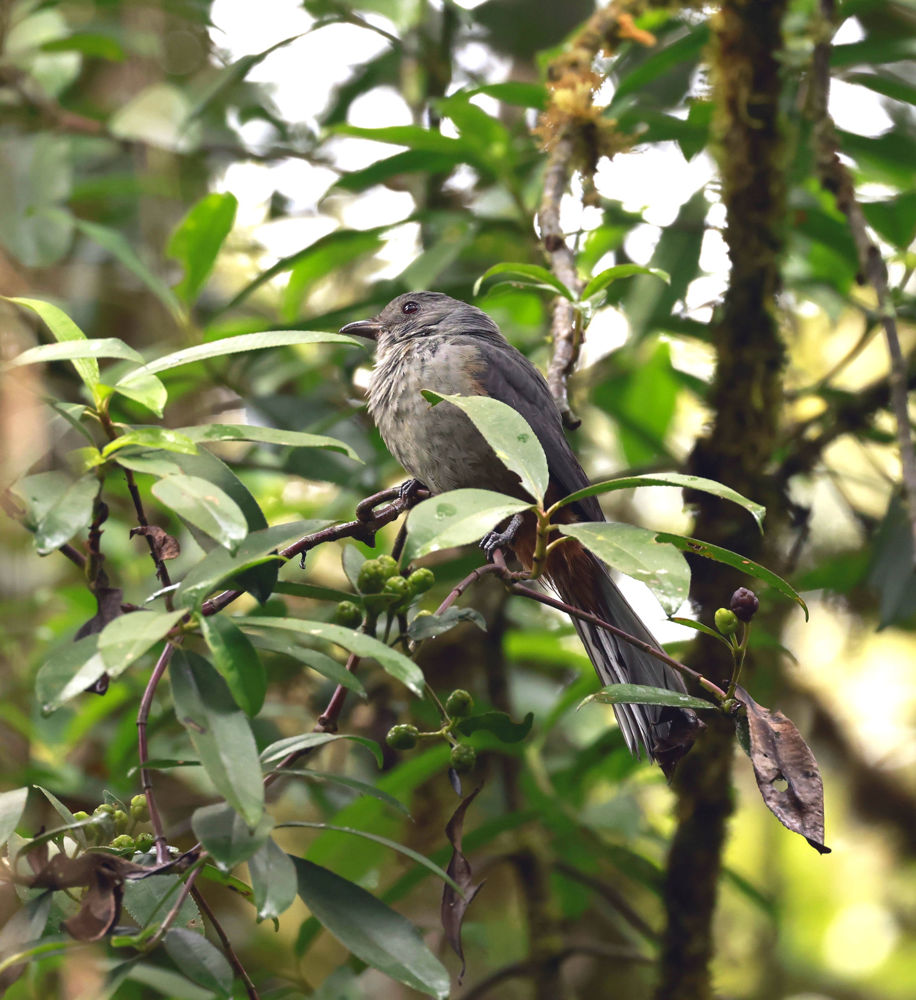
Mega rare Scimitar-winged Piha © Andrew Whittaker
At mid-elevation, we got exceptional studies of White-throated Quail-Doves on the road, while White-tipped Swifts zoomed over our heads. Amazingly, a hunting Orange-breasted Falcon passed a few feet over our heads, the loud whooshing causing most of us to duck! After much searching of the treetops, I managed to locate a stunning Chestnut-crested Cotinga. Other noteworthy observations included a Hooded Tinamou, a rare White-throated Hawk, Black-banded and Strong-billed woodcreepers, Long-tailed Sylph, Rufous-booted Racket-tail, Violet-fronted Brilliant, Cinnamon Flycatcher, Maroon-chested Chat-Tyrant, Streak-necked Flycatcher, Pale-legged Warbler, Purple Honeycreeper, Blue-naped Chlorophonia, Rufous-bellied Euphonia, and Masked Flowerpiercer. But the real stars here were exquisite male and female Andean Cocks-of-the-rock.
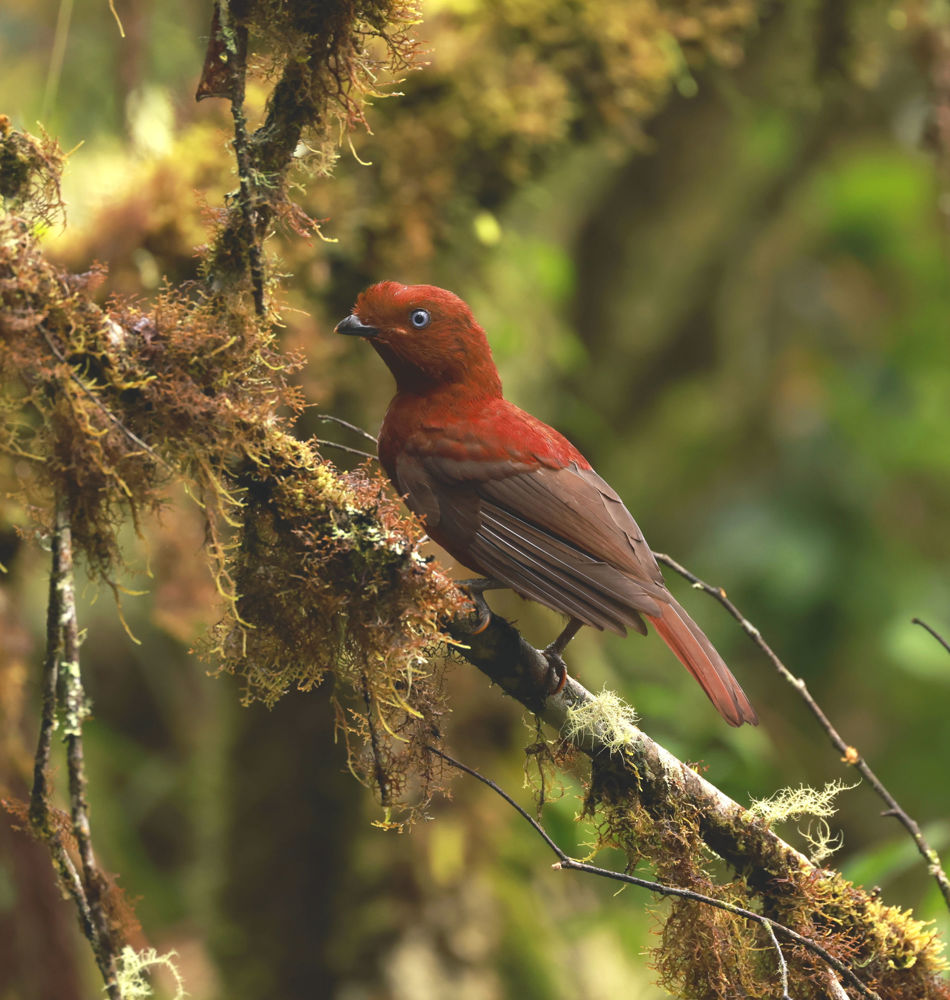
Andean Cock-of-the-rock female © Andrew Whittaker
On our last morning, we concentrated on high-elevation elfin forest. Here, a spectacular flock of colorful Hooded Mountain Tanagers and a Crimson-mantled Woodpecker kept us happy. A naughty pair of Undulated Antpittas simply would not show themselves. Higher up the road, we were blessed with mega studies of Rust-and-yellow Tanager, Tawny-rumped and White-banded tyrannulets, Bolivian Brushfinch, Blue-backed Conebill, and Scarlet-bellied Mountain Tanager.
Finally, our exploration of the high puna grasslands turned up very cute Southern Mountain Viscachas sunning on rocks. We also enjoyed great looks at Scribble-tailed Canastero (the best-looking member of that family), and Paramo Pipit and Puna Tapaculo appeared before we descended to La Paz and our plush hotel. We enjoyed a scrumptious Chinese lunch before relaxing and repacking in the Ritz. In the evening, we gathered for our farewell dinner at a great Japanese restaurant, where we toasted yet another fantastic Bolivia trip while marveling over our top seven trip birds.
Thank you all for joining me on this magical Bolivia trip and being such a fun group to share this fabulous country with. I just love Bolivia and its mega avifauna, still one of the best-kept South American birding secrets! Writing this, I am already looking forward to my return next autumn to this exceptional and friendly country that touched all our hearts. I hope you enjoy reading this report and it brings back some wonderful memories—and that we cross paths again on one of my exciting VENT tours worldwide.
Happy birding to you on our simply amazing planet!
Abrazos,
Andy
Seven Favorite Birds
- BLACK-HOODED SUNBEAM (ENDEMIC)
- HOODED MOUNTAIN-TOUCAN (NEAR-ENDEMIC)
- ANDEAN COCK-OF-THE-ROCK
- GOULD’S INCA
- TITICACA GREBE
- CRIMSON-MANTLED WOODPECKER
- SCIMITAR-WINGED PIHA
A complete list of the birds recorded on our tour can be found at: https://ebird.org/tripreport/422288
Description for the next departure of this tour.

